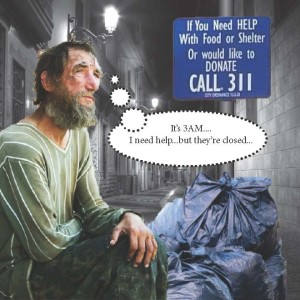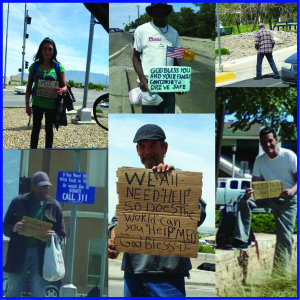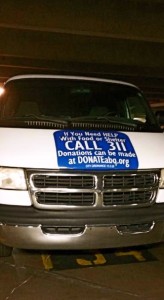By Jeremy Reynalds, Ph.D.
Founder and CEO
Joy Junction Inc.
It’s been about 15 months since blue signs sprouted like mushrooms all over Albuquerque encouraging people to call 311 instead of giving to panhandlers.
By so doing, those with a heart to help were told they could donate to local food banks, and the homeless or hungry unaware of local services would be informed where they could find food or shelter.
As a result of city touted success from this initiative, you can now see “There’s a Better Way” van on Albuquerque streets.
In partnership with a local non profit, the van currently circulates two days a week throughout the city and offer panhandlers a job for the day. It transports individuals to a job site under the supervision of the City of Albuquerque Solid Waste Department, to do work such as landscape beautification.
At the end of the workday, the city continued, workers receive their pay from St. Martin’s and are transported back to St. Martin’s “so they can get connected with an emergency shelter to house them overnight as needed or available.”
That’s if they can find the van, or the van can find them. In a recent local story, Albuquerque Mayor R. J. Berry suggested that the homeless call 311 to coordinate a pickup.
Okay, that sounds good, but there are some real problems with the initiative as a whole. Firstly, outside calling 311 for a pickup, those dialing 311 for help.
Of all those who called, I can’t help but wonder how many were referred to agencies that were either closed or not equipped to meet their needs.
That was a common occurrence when earlier in 2015, I had some of my staff go “undercover,” and pose as homeless people needing help.
In addition, let’s not forget that the 311 service is only open from 6am to 9pm six days a week, and not available for calls relating to homelessness on Sunday. That lack of 24/7 service is not something mentioned on those blue signs. In 2015, when asked by a reporter for KOAT what people should do after hours, the city reportedly said to call the non-emergency number for the police, 242-COPS. 
Yeah, let’s call our already overworked and troubled police department and bog the system down with more calls. Last time I had to call the non emergency issue for a personal issue a few weeks ago I was put (briefly) on hold. They’re busy!
Wouldn’t it have just been easier (and more honest) to put the hours of operation on the sign?
Now, I have no problem admitting that giving a job for the day to a few panhandlers willing and able to work is (potentially) a great idea. However, I do have still unanswered questions-which city administration has repeatedly failed to address-about liability issues if one of those individuals working for a day commits some sort of offence. Who ends up paying?
But let’s not pretend that this small program is an example for the nation, and that Albuquerque has gotten it together when it comes to panhandling and housing the homeless.
Sadly, that’s the impression given by some national media whose stories mostly relying on Albuquerque Mayor R. J. Berry’s “spin” have been picked up by many other regional and local publications.
Happily, Albuquerque NBC affiliate KOB’s Danielle Todesco took a much more credible and realistic look at the issue, pointing out that when thinking about the blue call 311 signs, there’s a certain irony about city panhandlers standing under them as a place to ask for help. I’m hoping (but not holding my breath) for national media to call Todesco, so they can get (as Paul Harvey used to say, “the rest of the story.” Let’s not forget in the mayor’s rush to rid the city of panhandlers that a number of those so doing have mental health issues, PTSD, felony backgrounds, and other challenges. They panhandle for a few hours, and at times and on days when they feel emotionally equipped to face (at least to some extent) some of the daily rigors of living.
Some individuals will always be dependent on the largesse of others, and we as a community have a moral and societal obligation to assist them. If people stop giving donations to them, how will they survive?
It’s a well known fact that many homeless adults have physical and other types of disabilities. According to one site, almost half (46 percent) reported chronic physical conditions.
Problems with alcohol, drugs, and mental health among homeless people are well documented and often occur together. Among adults using homeless services, 31 percent reported a combination of mental health and substance abuse problems (alcohol and/or drugs) within the past year.
An additional 17 percent reported problems with drugs and/or alcohol problems, but no mental health problems.
In addition, according to the same source, 12 percent reported only problems with alcohol, and 15 percent reported only mental health problems. Only one in four homeless adults did not report any mental health or substance abuse problems during the past year.
As politicians try to rid our city of panhandlers, let’s remember these interesting little nuggets of information. To do so may be discomforting, but for the sake of honesty, reality and our city’s collective humanity it’s a more important fact for us to remember than calling 311.




